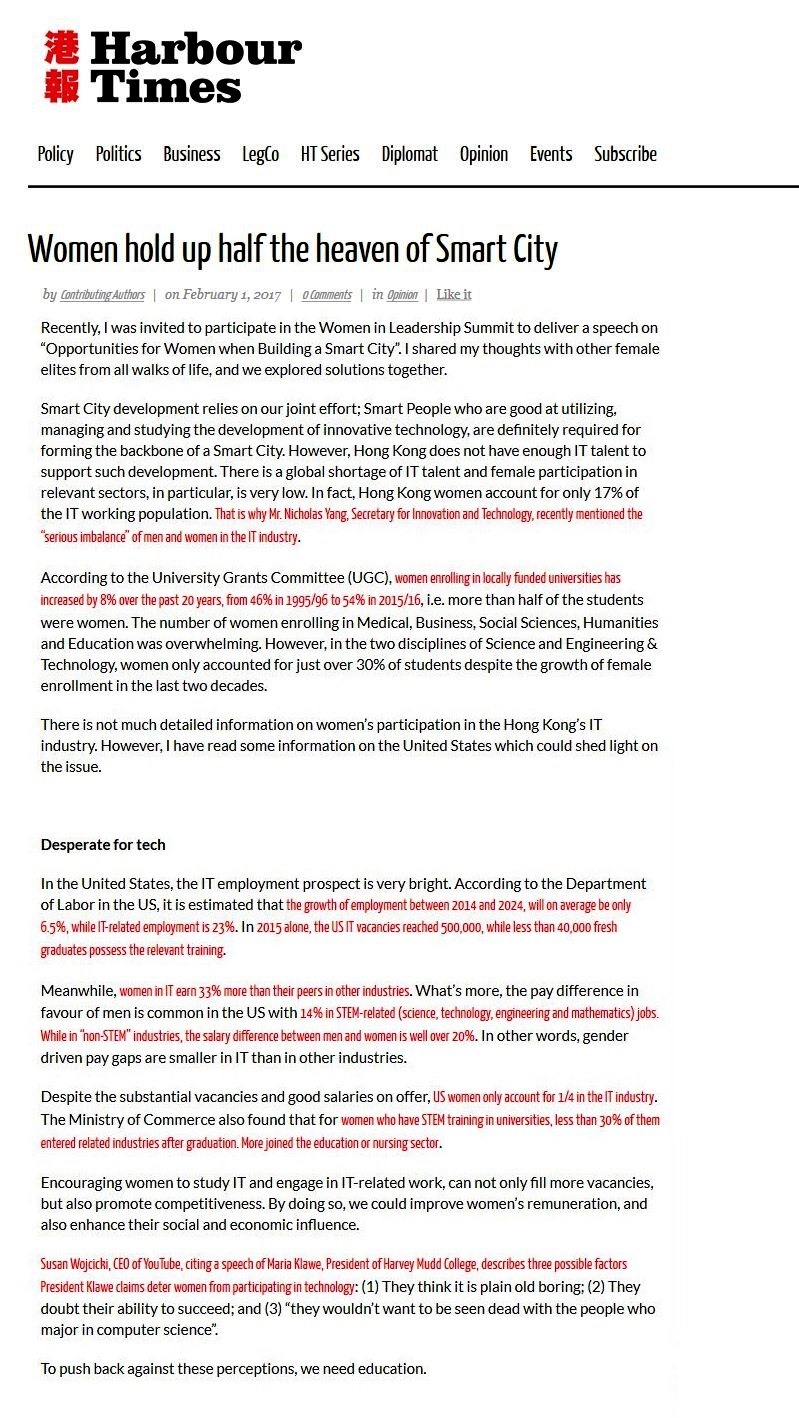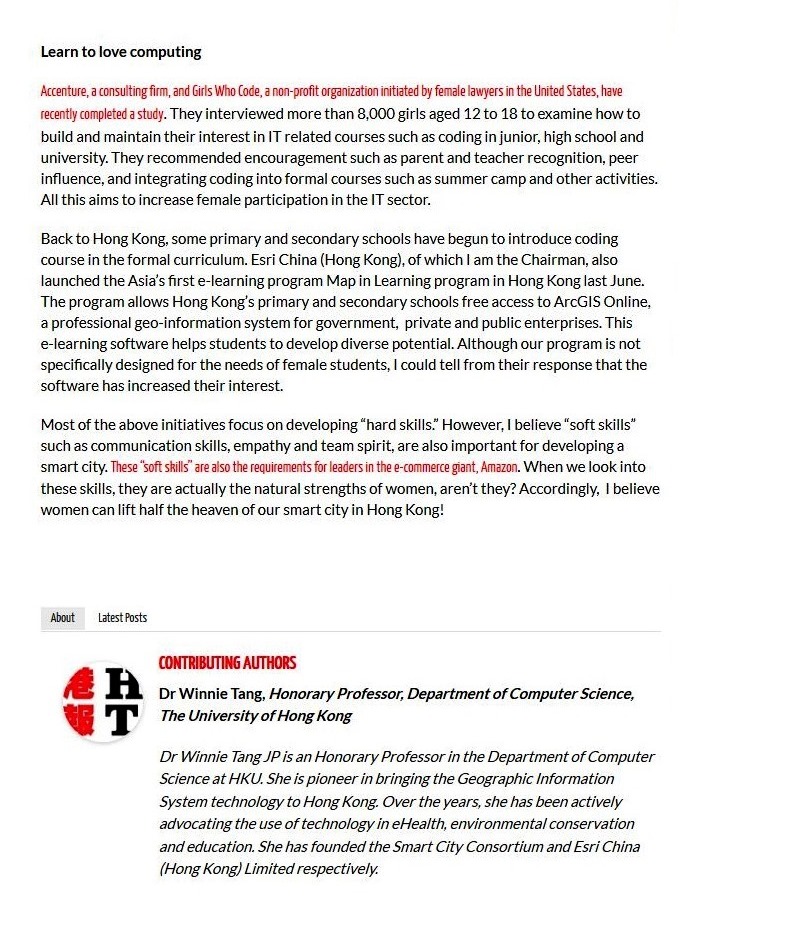網上版請按此


Women hold up half the heaven of Smart City
Recently, I was invited to participate in the Women in Leadership Summit to deliver a speech on “Opportunities for Women when Building a Smart City”. I shared my thoughts with other female elites from all walks of life, and we explored solutions together.
Smart City development relies on our joint effort; Smart People who are good at utilizing, managing and studying the development of innovative technology, are definitely required for forming the backbone of a Smart City. However, Hong Kong does not have enough IT talent to support such development. There is a global shortage of IT talent and female participation in relevant sectors, in particular, is very low. In fact, Hong Kong women account for only 17% of the IT working population. That is why Mr. Nicholas Yang, Secretary for Innovation and Technology, recently mentioned the “serious imbalance” of men and women in the IT industry.
According to the University Grants Committee (UGC), women enrolling in locally funded universities has increased by 8% over the past 20 years, from 46% in 1995/96 to 54% in 2015/16, i.e. more than half of the students were women. The number of women enrolling in Medical, Business, Social Sciences, Humanities and Education was overwhelming. However, in the two disciplines of Science and Engineering & Technology, women only accounted for just over 30% of students despite the growth of female enrollment in the last two decades.
There is not much detailed information on women's participation in the Hong Kong's IT industry. However, I have read some information on the United States which could shed light on the issue.
Desperate for tech
In the United States, the IT employment prospect is very bright. According to the Department of Labor in the US, it is estimated that the growth of employment between 2014 and 2024, will on average be only 6.5%, while IT-related employment is 23%. In 2015 alone, the US IT vacancies reached 500,000, while less than 40,000 fresh graduates possess the relevant training.
Meanwhile, women in IT earn 33% more than their peers in other industries. What's more, the pay difference in favour of men is common in the US with 14% in STEM-related (science, technology, engineering and mathematics) jobs. While in “non-STEM” industries, the salary difference between men and women is well over 20%. In other words, gender driven pay gaps are smaller in IT than in other industries.
Despite the substantial vacancies and good salaries on offer, US women only account for 1/4 in the IT industry. The Ministry of Commerce also found that for women who have STEM training in universities, less than 30% of them entered related industries after graduation. More joined the education or nursing sector.
Encouraging women to study IT and engage in IT-related work, can not only fill more vacancies, but also promote competitiveness. By doing so, we could improve women's remuneration, and also enhance their social and economic influence.
Susan Wojcicki, CEO of YouTube, citing a speech of Maria Klawe, President of Harvey Mudd College, describes three possible factors President Klawe claims deter women from participating in technology: (1) They think it is plain old boring; (2) They doubt their ability to succeed; and (3) “they wouldn’t want to be seen dead with the people who major in computer science”.
To push back against these perceptions, we need education.
Learn to love computing
Accenture, a consulting firm, and Girls Who Code, a non-profit organization initiated by female lawyers in the United States, have recently completed a study. They interviewed more than 8,000 girls aged 12 to 18 to examine how to build and maintain their interest in IT related courses such as coding in junior, high school and university. They recommended encouragement such as parent and teacher recognition, peer influence, and integrating coding into formal courses such as summer camp and other activities. All this aims to increase female participation in the IT sector.
Back to Hong Kong, some primary and secondary schools have begun to introduce coding course in the formal curriculum. Esri China (Hong Kong), of which I am the Chairman, also launched the Asia's first e-learning program Map in Learning program in Hong Kong last June. The program allows Hong Kong's primary and secondary schools free access to ArcGIS Online, a professional geo-information system for government, private and public enterprises. This e-learning software helps students to develop diverse potential. Although our program is not specifically designed for the needs of female students, I could tell from their response that the software has increased their interest.
Most of the above initiatives focus on developing “hard skills.” However, I believe “soft skills” such as communication skills, empathy and team spirit, are also important for developing a smart city. These “soft skills” are also the requirements for leaders in the e-commerce giant, Amazon. When we look into these skills, they are actually the natural strengths of women, aren’t they? Accordingly, I believe women can lift half the heaven of our smart city in Hong Kong!
Dr. Winnie Tang
Honorary Professor, Department of Computer Science, The University of Hong Kong